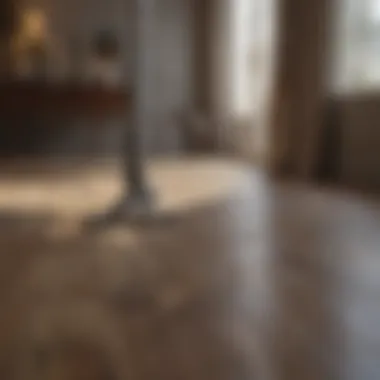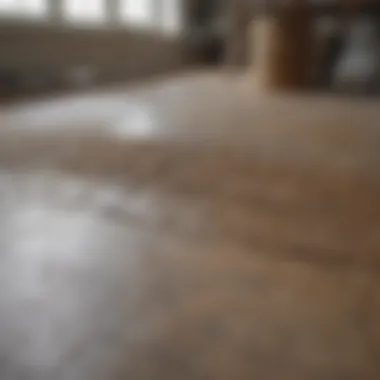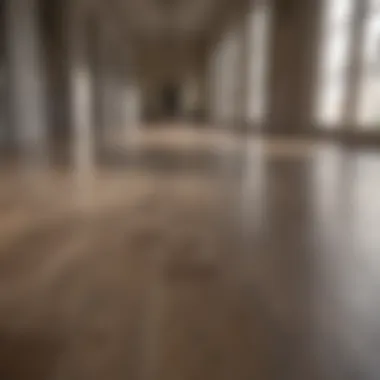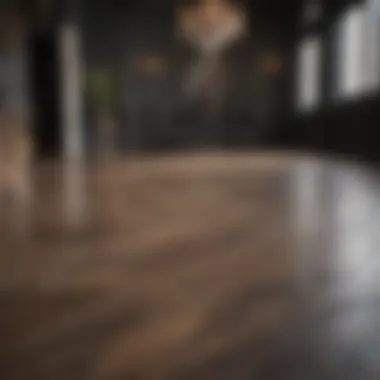A Comprehensive Guide to Installing Luxury Vinyl Tile (LVT) Flooring


Overview of Topic
Luxury Vinyl Tile (LVT) flooring falls under the home improvement industry, offering a durable and stylish alternative to traditional flooring materials. Its resemblance to natural materials like wood or stone along with its water-resistant properties make it a popular choice for homeowners seeking both aesthetics and functionality in their homes. The importance of LVT flooring lies in its easy maintenance, affordability, and ability to mimic high-end materials.
Common Challenges and Solutions
Homeowners often face challenges such as improper installation leading to gaps or uneven surfaces, difficulty in cutting edges for a perfect fit, and the risk of damaging the tiles during installation. To overcome these challenges, ensuring proper subfloor preparation, using the right tools for cutting, and following manufacturer instructions meticulously are crucial. Additionally, utilizing expansion joints, acclimating the tiles beforehand, and seeking professional help when needed can help tackle common installation issues.
Product Recommendations
When considering LVT flooring, industry-renowned brands such as [Industry Brand] offer a range of quality products to choose from. Their offerings come with features like easy click-lock systems for hassle-free installation, various styles and colors to suit different design preferences, and enhanced durability for long-lasting performance. By opting for products from these reputable brands, homeowners can ensure a smoother installation process and enjoy the benefits of premium quality flooring.
Step-by-Step Guide
- Start Planning: Measure the room dimensions, calculate the required amount of flooring, and acclimate the tiles in the room.
- Preparing the Subfloor: Ensure the subfloor is clean, level, and dry before laying down an underlayment to provide a smooth base.
- Laying the First Row: Begin in a corner, using spacers to maintain an expansion gap, and ensure the first row is straight.
- Cutting and Fitting: Use a utility knife or a vinyl cutter to trim tiles for edges and corners, ensuring a precise fit.
- Installing the Remaining Rows: Click-lock each tile into place, staggering seams for a more natural look.
- Applying Finishing Touches: Install transition strips, trim excess underlayment, and reattach baseboards for a polished appearance.
By following these detailed steps and tips, homeowners can successfully install LVT flooring in their spaces, enhancing both the beauty and functionality of their homes.
Introduction
In this comprehensive guide on installing Luxury Vinyl Tile (LVT) flooring, the importance of understanding the fundamental aspects of LVT installation cannot be overstated. Introducing the topic sets the foundation for a successful project, as it provides crucial insights into the process ahead. From selecting the right type of LVT to ensuring a proper installation, this article delves deep into every essential detail for both novice and experienced individuals.
Highlighting the significance of preparation and planning, the introduction serves as the gateway to a seamless LVT flooring installation experience. By grasping the intricacies early on, homeowners can avoid common pitfalls and streamline the overall process. Additionally, gaining a holistic view of the installation journey enables individuals to make informed decisions every step of the way, resulting in a polished final outcome that exudes quality and craftsmanship.
As we embark on this LVT flooring installation journey, understanding the core elements of the process, its benefits, and key considerations is essential. Whether it's the durability and aesthetic appeal of LVT flooring or the cost-effective and low-maintenance nature of this flooring option, each aspect plays a pivotal role in shaping the overall installation experience.
Understanding LVT Flooring
Luxury Vinyl Tile (LVT) flooring is a popular choice for homeowners due to its durability, affordability, and aesthetic appeal. In this comprehensive guide, understanding LVT flooring is crucial as it forms the foundation for a successful installation process. LVT flooring is designed to mimic the look of natural materials like hardwood or stone while providing benefits such as water resistance, easy maintenance, and comfort underfoot.
When considering LVT flooring, it is important to note its various elements, including the composition of multiple layers such as the wear layer, design layer, vinyl core, and backing. The wear layer protects against scratches and stains, while the design layer provides the floor's visual appearance. Understanding these layers ensures that homeowners make an informed choice best suited to their needs.
Furthermore, benefits of LVT flooring encompass its versatility in design options, ranging from wood finishes to intricate tile patterns. Its easy installation process makes it a practical choice for DIY enthusiasts. Additionally, LVT flooring is known for its resilience against moisture, making it ideal for areas prone to spills or high humidity.
Considerations when selecting LVT flooring include evaluating the thickness of the planks or tiles, as thicker options offer enhanced durability and noise reduction. Understanding the wear layer's thickness is crucial, as it indicates the floor's resistance to daily wear and tear. With a variety of installation methods available, such as click-lock or adhesive, homeowners can choose the option that aligns with their skill level and preferences. By comprehensively understanding LVT flooring, homeowners can make informed decisions and enjoy the benefits of a long-lasting and visually appealing flooring solution.
Tools and Materials Required


When embarking on the installation of Luxury Vinyl Tile (LVT) flooring, equipping oneself with the appropriate tools and materials is paramount to ensure a smooth and successful process. Having the right tools not only enhances efficiency but also guarantees precision and quality in the final result. To carry out the installation seamlessly, you will need a range of tools that serve different functions, from measuring and cutting to securing the planks in place.
Essential Tools
In the realm of essential tools, a tape measure emerges as indispensable. This tool aids in accurate measurements, crucial for fitting the LVT flooring precisely. Additionally, a utility knife proves to be a fundamental ally in cutting the planks to the required dimensions, ensuring a seamless and tailored installation. Other essential tools include a T-square for ensuring precise cuts and a rubber mallet for gently tapping the planks into place, guaranteeing a secure fit without causing any damage.
Materials Checklist
Beyond tools, assembling the necessary materials is a crucial step in the installation process. LVT flooring adhesive is a primary component that ensures the planks adhere firmly to the subfloor, providing stability and longevity to the flooring. Underlayment serves as a protective layer, providing cushioning and noise reduction while also safeguarding against moisture. Transition strips are essential for creating smooth transitions between different flooring types or connecting areas. Don't forget about the LVT flooring itself – selecting high-quality planks in the desired color and thickness is key to achieving a visually appealing and durable result.
By meticulously curating your arsenal of tools and materials as outlined above, you set a strong foundation for a successful LVT flooring installation project. Ensuring that each component is of high quality and suited to the task at hand will pay off in the form of a flawless and long-lasting flooring solution.
Preparing the Subfloor
In the process of installing Luxury Vinyl Tile (LVT) flooring, preparing the subfloor plays a crucial role in ensuring a durable and long-lasting outcome. Before laying down the LVT planks, it is essential to dedicate sufficient time and effort to the subfloor preparation, as it sets the foundation for the entire flooring project. Neglecting this step can lead to issues such as uneven flooring, premature wear and tear, and even damage to the LVT planks over time.
By focusing on preparing the subfloor meticulously, homeowners can address any underlying issues that may affect the installation or performance of the LVT flooring. Additionally, a well-prepared subfloor promotes better acoustics, enhances thermal insulation, and provides a stable base for the flooring material, contributing to a more comfortable and durable end result.
When preparing the subfloor for LVT installation, it is important to consider factors such as moisture levels, existing flooring material, subfloor condition, and compatibility with the LVT flooring product chosen. Properly preparing the subfloor can extend the longevity of the flooring, reducing the need for repairs or replacements in the future.
Subfloor Inspection
Prior to installing LVT flooring, conducting a thorough subfloor inspection is vital to identify any existing issues that need to be addressed. Subfloor inspection involves checking for uneven surfaces, moisture damage, cracks, or deformities that could impact the installation process and the overall performance of the flooring.
During the inspection, it is recommended to use appropriate tools to measure the moisture content of the subfloor, assess its stability, and detect any signs of damage. Identifying and documenting any issues found during the inspection will help in planning the necessary repairs and treatments before proceeding with the LVT installation.
Subfloor Repair
Subfloor repair is a critical step in ensuring the success of the LVT flooring installation. After conducting a comprehensive inspection, homeowners should promptly address any issues discovered to prevent them from affecting the new flooring. Common subfloor repairs may include filling cracks, leveling uneven surfaces, replacing damaged subfloor sections, or applying sealants to protect against moisture.
By addressing subfloor repairs thoroughly, homeowners can create a stable and even surface for the LVT flooring, minimizing the risk of future damage and ensuring a smooth and professional installation process.
Acclimating the LVT Flooring
Acclimating the LVT flooring is a crucial step in the installation process to ensure a seamless and long-lasting flooring application. It involves allowing the flooring materials to adjust to the temperature and humidity of the installation environment. This process is vital as it helps prevent issues such as warping, buckling, or gaps after installation. By acclimating the LVT flooring, you are essentially giving it the opportunity to expand or contract before being installed, reducing the likelihood of problematic issues later on.
Benefits of Acclimating LVT Flooring
Acclimating LVT flooring before installation offers numerous benefits. Firstly, it helps in maintaining the stability of the flooring material, which is essential for a uniform and professional installation. Additionally, acclimating allows the adhesive or locking mechanism to set effectively, promoting a secure and durable flooring surface. Moreover, acclimating the flooring can also enhance the visual appeal of the final installation by decreasing the chances of unsightly gaps or uneven seams.


Considerations for Acclimating LVT Flooring
When acclimating LVT flooring, it is important to consider the ambient conditions of the installation area. Ideally, the flooring should be stored in the room where it will be installed for a minimum of 48 hours. The temperature and humidity levels of the space should be consistent with the manufacturer's recommendations to ensure proper acclimation. It is also essential to keep the boxes of flooring material unopened during acclimation to prevent any exposure to abrupt environmental changes.
Layout Planning
Layout planning is a crucial stage in the process of installing Luxury Vinyl Tile (LVT) flooring. It sets the foundation for a successful and visually appealing outcome. By meticulously planning the layout, you can ensure efficient use of materials, minimize waste, and achieve a seamless installation.
Proper layout planning starts with assessing the dimensions of the area where the flooring will be installed. Accurate measurements are essential to determine the quantity of LVT planks needed and to avoid mistakes during installation. Precision is key during this phase to prevent costly errors and delays.
Moreover, layout planning allows you to visualize how the flooring will look once installed. It helps in determining the best orientation of the planks for a harmonious and balanced appearance. By considering factors such as natural light sources, room dimensions, and traffic flow, you can strategically plan the layout to enhance the overall aesthetic of the space.
Additionally, creating a layout plan enables you to anticipate any challenges that may arise during installation. By identifying potential obstacles or irregularities in the subfloor, you can proactively address them before laying down the LVT flooring. This meticulous approach can save time and effort by preventing last-minute adjustments.
Furthermore, efficient layout planning involves marking out specific areas for cutting and fitting the planks. By mapping out these zones in advance, you can streamline the installation process and ensure a professional finish. Attention to detail at this stage can significantly impact the final result, leading to a polished and flawless floor surface.
In summary, layout planning is a critical aspect of installing LVT flooring that demands careful consideration and meticulous attention to detail. By embracing this preparatory stage with precision and foresight, you can lay the groundwork for a successful and visually pleasing outcome.
Measuring and Marking
Measuring and marking are fundamental steps in the layout planning process when installing LVT flooring. Accurate measurements and strategic markings are vital for ensuring a precise fit and a visually appealing result.
When measuring the area where the LVT flooring will be installed, it is important to use precise measuring tools such as a tape measure or laser measure. Taking measurements multiple times and cross-verifying the dimensions can help avoid errors and discrepancies that could complicate the installation process.
After obtaining accurate measurements, marking the layout on the subfloor allows you to visualize the placement of the planks before installation. Using chalk lines or pencil markings, you can create a guide that outlines the orientation and arrangement of the flooring planks.
Strategic marking is especially crucial when dealing with patterns or intricate designs. By marking out key reference points or starting positions, you can ensure a symmetrical layout and avoid misalignments or irregularities.
Additionally, marking areas for specific cuts or adjustments can streamline the installation process and minimize wastage. Clearly indicating where to trim or tailor the planks allows for efficient execution and a seamless transition between different sections of the flooring.
Moreover, precise measuring and marking contribute to the overall precision of the installation, resulting in a polished and professional finish. By meticulously following this step, you set the stage for a successful and visually stunning LVT flooring installation.
Direction of Installation
The direction of installation plays a crucial role in determining the visual impact and structural integrity of the LVT flooring. Opting for the right direction enhances the aesthetic appeal of the space and influences the overall durability of the floor.
One key consideration when selecting the direction of installation is the natural light source in the room. Installing the LVT flooring parallel to incoming light can create an illusion of depth and expansiveness, making the room appear more spacious and inviting.
Furthermore, aligning the flooring with the primary line of sight or the longest wall in the room can accentuate the dimensions and proportions of the space. This strategic placement enhances the overall flow and coherence of the room's design, creating a visually appealing environment.


Moreover, the direction of installation can affect the durability and stability of the flooring. Installing the planks perpendicular to the floor joists can bolster the structural integrity of the floor, minimizing the risk of sagging or uneven surfaces over time. By considering the underlying subfloor structure, you can enhance the longevity and performance of the LVT flooring.
Additionally, the direction of installation influences the perceived texture and pattern of the flooring. Depending on the desired aesthetic outcome, choosing a specific orientation can highlight certain design elements or create a sense of continuity throughout the space.
Installation Process
Installing Luxury Vinyl Tile (LVT) flooring is a crucial part of this comprehensive guide, marking the transition from preparation to the actual transformation of your space. The installation process involves several key elements that contribute to the durability, aesthetics, and functionality of the flooring. Understanding how to correctly install LVT ensures a successful outcome that enhances the overall appeal of your home.
Starting the Installation
Initiating the installation process sets the foundation for a seamless and polished end result. Starting correctly ensures that the entire installation progresses smoothly and without setbacks. Clearing the installation area, preparing the tools, and understanding the layout are key components of this phase. Progressing methodically from the starting point ensures that each subsequent plank is laid accurately, avoiding potential issues later in the process.
Cutting and Fitting
Cutting and fitting the LVT planks require precision and attention to detail. Measurements must be accurate to ensure a tight fit and seamless appearance. Proper tools and techniques for cutting the planks without causing damage are essential. Fitting the planks together snugly is crucial to prevent gaps or buckling. Careful cutting and fitting ensure a professional-looking finish that enhances the beauty of the flooring.
Securing the Planks
Securing the LVT planks effectively is necessary to maintain the integrity of the flooring over time. Properly securing the planks ensures that they remain in place despite foot traffic and everyday use. Understanding the correct methods for securing the planks, whether through adhesive, click-lock systems, or other mechanisms, is vital. Securing the planks securely enhances the longevity and stability of the flooring, providing peace of mind for years to come.
Finishing Touches
In the process of installing Luxury Vinyl Tile (LVT) flooring, the Finishing Touches hold immense significance as they add the final polish to the entire project, ensuring a seamless and professional end result. These touches not only enhance the aesthetics of the floor but also contribute to its durability and longevity. Emphasizing the Finishing Touches is paramount in achieving a high-quality finish that complements the entire space. It encapsulates the attention to detail and precision required for a flawless LVT flooring installation.
Trim Installation
Trim Installation plays a pivotal role in completing the look of LVT flooring by providing a polished edge that covers the necessary gaps left around the perimeter of the room. The installation of trims ensures a smooth transition between the flooring and walls, concealing expansion gaps and enhancing the overall appearance. It serves both functional and aesthetic purposes by offering a neat and structured finish to the flooring, creating a sophisticated and cohesive look throughout the space.
Transition Strips
Transition Strips are essential components in LVT flooring installation, serving as connectors between different types of flooring or different rooms. These strips not only provide a seamless transition between various floorings with different heights or materials but also offer protection to the edges, preventing potential damage. Additionally, Transition Strips contribute to the safety of the space by reducing tripping hazards and enhancing the overall visual appeal of the flooring. Properly selecting and installing transition strips is crucial to achieving a professional and unified look in the LVT flooring project.
Maintenance Tips
Maintaining your LVT flooring is crucial to ensure its longevity and keep it looking as good as new. By implementing proper maintenance tips, you can protect your investment and enjoy a beautiful floor for years to come.
One essential maintenance tip is to regularly sweep or vacuum the flooring to remove dirt, dust, and debris that can scratch the surface. Using a soft-bristle broom or a vacuum with a brush attachment will help prevent any damage to the LVT planks. Additionally, consider using a damp mop with a mild cleaning solution specifically designed for LVT floors. Avoid harsh chemicals or abrasive cleaners, as they can cause fading or scratching.
Another key aspect of maintenance is to place protective pads under heavy furniture to prevent scratches and dents. When moving furniture, lift it instead of dragging it across the floor to avoid leaving marks. Furthermore, using rugs or mats at entryways can help trap dirt and moisture before it reaches the LVT flooring, reducing wear and tear.
Regularly inspecting the floor for any signs of damage or wear is also essential. Address any issues promptly to prevent them from worsening. For example, if you notice a loose plank or a small scratch, repair it immediately according to the manufacturer's instructions to maintain the integrity of the floor.
In addition to these tips, it's recommended to avoid exposing the LVT flooring to direct sunlight for prolonged periods, as this can cause fading and discoloration. Using window treatments or UV-resistant coatings can help protect the floor from sun damage.
Overall, by following these maintenance tips diligently, you can preserve the beauty and functionality of your LVT flooring, ensuring a lasting and visually appealing home environment.







